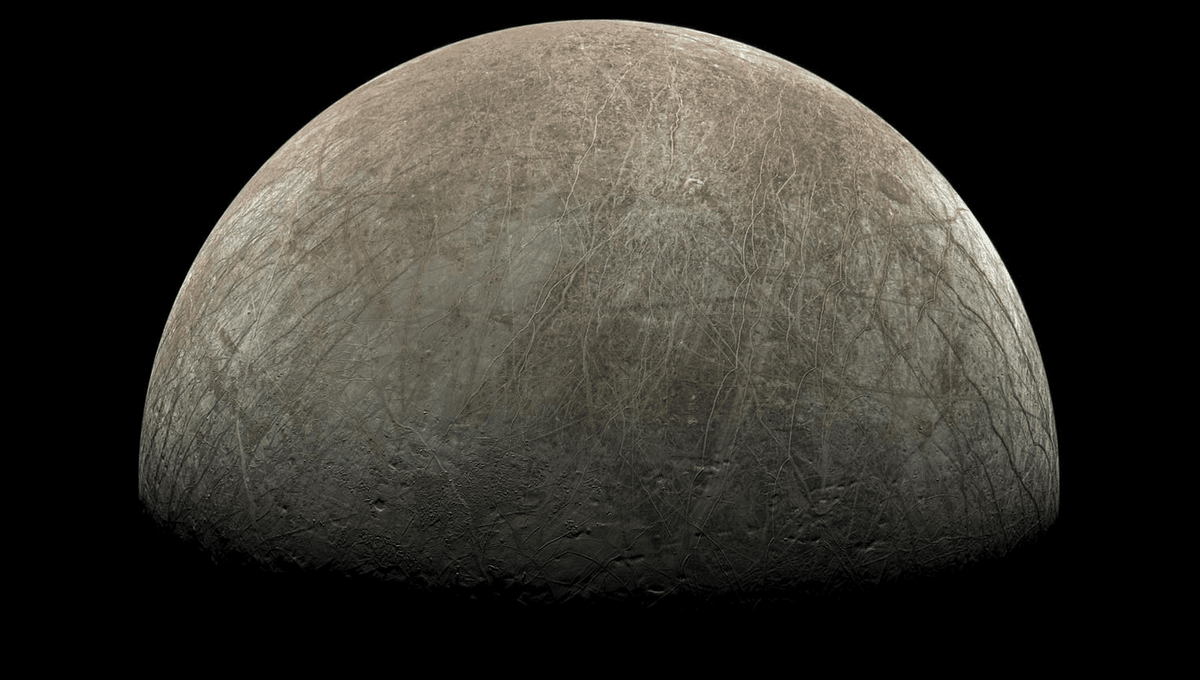
The icy crust that protects Europa’s ocean from the cold of space is at least 20 kilometers (12 miles) thick, an analysis of data from the Galileo mission suggests. The conclusion sheds no light on the question of whether that ocean contains life, but indicates how hard it will be to find a conclusive answer.
Evidence for an ocean inside Jupiter’s moon Europa dates back to the Voyager spacecraft, with the Galileo mission strengthening the case. The discovery inspired scientists and science fiction writers alike. We now know that many icy worlds in the outer Solar System share this trait, but Europa remains of prime interest not just because it was the first. The dust thrown off from nearby Io’s volcanoes gives Europa the potential for more complex chemistry than other worlds with internal oceans.
A possible obstacle to Europa’s status as ground zero for astrobiology research would be an excessively thick crust. Previous observations have not been able to determine how close to the surface the liquid water gets; efforts to answer the question have produced estimates ranging from a few kilometers to 10 times that. By comparison, the ocean within Enceladus, while much smaller and possibly much younger, escapes into space through geysers at the south pole, providing an opportunity to sample it directly, as well as suggesting it might not be too hard to get a sufficiently flexible robot down there.
Europa’s surface is the smoothest in the Solar System, thanks to the movements of its ice, but it nevertheless carries some traces of past impacts from space. A team led by MIT’s Dr Shigeru Wakita realized two of these, known as Tyre and Callanish, could be key to determining crustal thickness.
Tyre and Callanish are both multiring basins. Wakita and co-authors modeled what would happen with asteroids of appropriate size hitting crusts of differing thickness and concluded only ice at least 20 kilometers thick would result in something like what we see. The figure is a minimum; Europa’s crust may be a great deal thicker. If the crust is 15 kilometers (9 miles) thick, multiring craters of this size would be much deeper.
Europa’s crust may not be the same thickness everywhere. Just as Enceladus’s ocean is thought to be much closer to the surface near the south pole than elsewhere, Europa may have regions of thinner ice. The authors consider it unlikely the variation is large, and the similarity of the results they get at two locations doesn’t favor the idea we’d just need to land a drilling rig in the right spot.
The authors also find that Europa’s ice is composed of layers with different thermal properties. The outermost part, 6-8 kilometers (3.7-5 miles) thick, is conductive, while below this lies relatively warm convecting ice.
Previous observations of the central peaks within some of Europa’s craters have been used as evidence the heat of the impacts did not melt all the way through to the ocean below. Using these craters’ sizes, planetary scientists could calculate the heat generated, and therefore the crust must be at least 3-4 kilometers (1.8-2.4 miles) thick, but this represented a minimum only. Comparisons of the shapes of small and large craters hint that the rigid ice of the surface only extends down around 7 kilometers (4.3 miles), without revealing whether it rests on softer ice, or directly on water.
Mulitring craters are produced by a complex process in which an impacting object produces a shockwave and a series of temporary formations that collapse in turn, leaving behind a wide basin with surrounding rings. The extra opportunities created by this multistage process allow ice models to rule out various pre-existing conditions, including ice less than 20 kilometers deep.
Jovian moons Ganymede and Callisto are also thought to possibly contain internal oceans but with much thicker shells than Europa. The authors suggest that past estimates of 80-105 kilometers (50-60 miles) may be considerably underestimating these moons’ crustal thickness.
The study is open access in Science Advances.
Source Link: Europa’s Ocean Is Covered By An Icy Shell At Least 20 Kilometers Thick